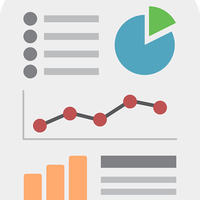How to do Research for an Infographic
Would you have a great infographic without great research?
I've seen some visually compelling infographics with some horrible data, and I've seen some horribly designed infographics with fantastic data.
It's really important that there's a balance between the research and the design. Research is essential to an infographics foundation.
It's the skeletal structure of the whole piece and when you have strong research, and a great design from the research, then it can be more balanced. It really comes across as a more authoritative and trustworthy content piece. You want to keep in mind the following while you're researching your topic.
Find data that is compelling to the target audience.
Keep the copy informative but at the same time straightforward and concise. Collect all of your sources in a spreadsheet that is structured like a story, with an introduction, a hook stat or stats, sections, and a conclusion or takeaway. .govs, edus, and . orgs can be great sources, but you want to make sure that you do the following: Find information that validates what your looking for and helps you understand the topic.
Use sites that speak authoritatively. Use sites that reference their sources. Be aware of timely data as it could have been updated making it outdated. Know the author you are collecting info from. Are they reputable? Know what type of sources your audience values. Different topics and audiences will find certain sources more reputable than others. Stay away from open sourced sites like wikipedia for research. It could be wrong. There are many different types of research to look out for Customer surveys Polls Reports Presentations Sometimes even intellectual coworkers.
All of these can be a good source of information to help form your infographic. Just make sure to cite them in your graphic! Go beyond the surface with research. Take the time to dig in and go past the first pages results from your search query. Also, go to the original source of the information.
A blog post citing stats may be compelling, but it may also be altered to favor a specific viewpoint of an author. While your digging deep, past the surface for data, be open to letting the research drive the topic.
Do not pigeon hole yourself into a specific direction for the research just yet. Let the research take the wheel so the information naturally unfolds.
By having this broad approach, you are opening up yourself to coming across more content possibilities. So in your spreadsheet have an area to collect future content idea possibilities. Also, while your looking, try to find some research that taps into the emotions.
When emotions are present, a stronger connection can be made, increasing audience retention. Once everything is collected.
Go through and sculpt your research into a compelling story. Lean on the idea of showing your data, not telling it. Also, while you sculpt away, don't delete any data from the spreadsheet. Its better to move it to a location within the sheet separate from what you will use. Dont let the deleted data be the missing puzzle piece to your masterpiece. Know your research.
You need to understand what needs to be designed. To know what needs to be designed, you need some one-on-one time with your research. By doing so, you are putting the information in the limelight and will be able to better speak to the data by showing it in the most compelling way possible. With the right knowledge on how to research for an infographic, you can create a more compelling content piece.
A content piece that can not only drive traffic, but build up an authoritative voice for your brand.

